Spatial and Temporal Deposition Rate of Beach Litter in Cadiz Bay (Southwest Spain)
Abstract
:1. Introduction
2. Study Area
3. Materials and Methods
3.1. Wave and Wind Data
3.2. Sampling Method
3.3. Data Analysis
4. Results and Discussions
4.1. Beach Litter Spatial and Temporal Distribution
4.2. Beach Litter Composition
- Autumn 2022: cigarette butts (1746 items); fragments of non-foamed plastic 2.5–50 cm (985 items); plastic crisps packets/sweets wrappers (297 items); fragments of foamed polystyrene 2.5–50 cm (181 items); other identifiable non-foamed plastic items (177 items); plastic string and cord (Ø < 1 cm) not from dolly ropes or unidentified (96 items); other identifiable foamed plastic items (85 items); plastic cotton bud sticks (68 items); plastic shopping/carrier/grocery bags (56 items); other processed wooden items 2.5–50 cm (51 items).
- Spring 2023: plastic wet wipes (900 items); cigarette butts (514 items); plastic crisps packets/sweets wrappers (423 items); fragments of non-foamed plastic 2.5–50 cm (339 items); fragments of foamed polystyrene 2.5–50 cm (211 items); other plastic string and filaments exclusively from fishery (167 items); plastic shopping/carrier/grocery bags (150 items); pieces of glass/ceramic (glass or ceramic fragments ≥ 2.5 cm) (142 items); plastic tangled wet wipes (142 items); plastic fishing line (120 items).
4.3. Hydrodynamic and Wind Conditions
5. Final Considerations
Author Contributions
Funding
Institutional Review Board Statement
Informed Consent Statement
Data Availability Statement
Acknowledgments
Conflicts of Interest
Appendix A
| Beach | Weight of Items m−1 | Weight of Items m−2 | ||||
|---|---|---|---|---|---|---|
| Autumn | Spring | Total | Autumn | Spring | Total | |
| La Calita | 1.60 ± 0.94 | 0.64 ± 0.57 | 1.64 ± 1.86 | 0.32 ± 0.19 | 0.13 ± 0.11 | 0.22 ± 0.18 |
| La Muralla | 0.52 ± 0.51 | 0.34 ± 0.29 | 0.71 ± 1.02 | 0.24 ± 0.12 | 0.07 ± 0.06 | 0.16 ± 0.13 |
| El Aculadero | 0.54 ± 0.50 | 0.52 ± 0.50 | 0.90 ± 1.54 | 0.33 ± 0.27 | 0.10 ± 0.10 | 0.22 ± 0.23 |
| El Castillito | 1.39 ± 1.62 | 0.87 ± 1.15 | 1.72 ± 2.71 | 0.32 ± 0.30 | 0.17 ± 0.23 | 0.24 ± 0.27 |
| La Puntilla | 2.83 ± 1.87 | 6.49 ± 3.94 | 9.35 ± 19.22 | 0.57 ± 0.37 | 1.30 ± 0.79 | 0.93 ± 0.71 |
| Valdelagrana 1 | 1.61 ± 1.52 | 0.70 ± 0.96 | 1.59 ± 2.13 | 0.32 ± 0.30 | 0.14 ± 0.19 | 0.23 ± 0.26 |
| Valdelagrana 2 | 0.70 ± 0.94 | 1.65 ± 1.13 | 2.42 ± 4.90 | 0.14 ± 0.19 | 0.33 ± 0.23 | 0.23 ± 0.22 |
| Total | 1.31 ± 0.83 | 1.60 ± 2.20 | 3.01 ± 3.02 | 0.32 ± 0.13 | 0.32 ± 0.44 | 0.28 ± 0.27 |
References
- UNEP. Marine Litter: An Analytical Overview; UNEP: Nairobi, Kenya, 2005; p. 47. [Google Scholar]
- Galgani, F.; Leaute, J.P.; Moguedet, P.; Souplet, A.; Verin, Y.; Carpentier, A.; Goraguer, H.; Latrouite, D.; Andral, B.; Cadiou, Y. Litter on the sea floor along European coasts. Mar. Pollut. Bull. 2000, 40, 516–527. [Google Scholar] [CrossRef]
- Galgani, F.; Hanke, G.; Werner, S.; DeVrees, L. Marine litter within the European Marine Strategy Framework Directive. ICES J. Mar. Sci. 2013, 70, 1055–1064. [Google Scholar] [CrossRef]
- Cózar, A.; Martí, E.; Duarte, C.M.; García-de-Lomas, J.; van Sebille, E.; Ballatore, T.J.; Eguíluz, V.M.; González-Gordillo, J.I.; Pedrotti, M.L.; Echevarría, F.; et al. The Arctic Ocean as a dead end for floating plastics in the North Atlantic branch of the Thermohaline Circulation. Sci. Adv. 2017, 3, 1600582. [Google Scholar] [CrossRef] [PubMed]
- Seas at Risk. Circular Economy: Reducing Marine Litter at Its Source. 2016, p. 2. Available online: www.seas–at-risk.org (accessed on 15 February 2019).
- Allsopp, M.; Walters, A.; Santillo, D.; Johnston, P. Plastic Debris in the World’s Oceans; Greenpeace: Exeter, UK, 2006. [Google Scholar]
- Ruiz, I.; Rubio, A.; Abascal, A.J.; Basurko, O.C. Modelling floating riverine litter in the south-eastern Bay of Biscay: A regional distribution from a seasonal perspective. Ocean Sci. 2022, 18, 1703–1724. [Google Scholar] [CrossRef]
- Grelaud, M.; Ziveri, P. The generation of marine litter in Mediterranean island beaches as an effect of tourism and its mitigation. Sci. Rep. 2020, 10, 20326. [Google Scholar] [CrossRef]
- Coe, J.M.; Rogers, D.B. Marine Debris: Sources, Impacts and Solutions; Springer: New York, NY, USA, 1997; p. 432. [Google Scholar]
- Ryan, P.G. The importance of size and buoyancy for long-distance transport of marine debris. Environ. Res. Lett. 2015, 10, 084019. [Google Scholar] [CrossRef]
- Convey, P.; Barnes, D.K.; Morton, A. Debris accumulation on oceanic island shores of the Scotia Arc, Antarctica. Polar. Biol. 2002, 25, 612–617. [Google Scholar] [CrossRef]
- Chiba, S.; Saito, H.; Fletcher, R.; Yogi, T.; Kayo, M.; Miyagi, S.; Ogido, M.; Fujikura, K. Human footprint in the abyss: 30 year records of deep-sea plastic debris. Mar. Policy 2018, 96, 204–212. [Google Scholar] [CrossRef]
- Aguilar, R.; Marín, P.; Álvarez, H.; Blanco, J.; Sánchez, N. Plastic in the Deep: An Invisible Problem. In How the Seafloor Becomes a Plastic Trap; Oceana: Washington, DC, USA, 2020; p. 24. [Google Scholar]
- Forrester, D.J.; White, F.H.; Woodard, J.C.; Thompson, N.P. Intussusception in a Florida manatee. J. Wildl. Dis. 1975, 11, 566–568. [Google Scholar] [CrossRef]
- Cadee, G.C. Seabirds and floating plastic debris. Mar. Pollut. Bull. 2002, 44, 1294–1295. [Google Scholar] [CrossRef]
- Romeo, T.; Pietro, B.; Pedà, C.; Consoli, P.; Andaloro, F.; Fossi, M.C. First evidence of presence of plastic debris in stomach of large pelagic fish in the Mediterranean Sea. Mar. Pollut. Bull. 2015, 95, 358–361. [Google Scholar] [CrossRef] [PubMed]
- Walker, T.R.; Reid, K.; Arnould, J.P.; Croxall, J.P. Marine debris surveys at bird island, south Georgia 1990–1995. Mar. Pollut. Bull. 1997, 34, 61–65. [Google Scholar] [CrossRef]
- Barnes, D.K. Biodiversity: Invasions by marine life on plastic debris. Nature 2002, 416, 808. [Google Scholar] [CrossRef] [PubMed]
- Kiessling, T.; Gutow, L.; Thiel, M. Marine Litter as Habitat and Dispersal Vector. In Marine Anthropogenic Litter; Springer: Cham, Switzerland, 2015; pp. 141–181. [Google Scholar] [CrossRef]
- Rochman, C.M.; Hentschel, B.T.; Teh, S.J. Long-term sorption of metals is similar among plastic types: Implications for plastic debris in aquatic environments. PLoS ONE 2014, 9, e85433. [Google Scholar] [CrossRef] [PubMed]
- Lau, W.W.Y.; Shiran, Y.; Bailey, R.M.; Cook, E.; Stuchtey, M.R.; Koskella, J.; Velis, C.A.; Godfrey, L.; Boucher, J.; Murphy, M.B.; et al. Evaluating Scenarios toward Zero Plastic Pollution. Science 2020, 369, 1455–1461. [Google Scholar] [CrossRef]
- Krelling, A.P.; Williams, A.T.; Turra, A. Differences in perception and reaction of tourist groups to beach marine debris that can influence a loss of tourism revenue in coastal areas. Mar. Policy 2017, 85, 87–99. [Google Scholar] [CrossRef]
- Williams, A.T.; Micallef, A. Beach Management. In Principles and Practice; Earthscan: London, UK, 2009; p. 480. [Google Scholar]
- Williams, A.T.; Pond, K.; Ergin, A.; Cullis, M.J. The hazards of beach litter. In Coastal Hazards; Springer: Dordrecht, The Netherlands, 2013; pp. 753–780. [Google Scholar]
- Martinez-Ribes, L.; Basterretxea, G.; Palmer, M.; Tintoré, J. Origin and abundance of beach debris in the Balearic Islands. Sci. Mar. 2007, 71, 305–314. [Google Scholar] [CrossRef]
- Hong, S.; Lee, J.; Jang, Y.C.; Kim, Y.J.; Kim, H.J.; Han, D.; Hong, S.H.; Kang, D.; Shim, W.J. Impacts of marine debris on wild animals in the coastal area of Korea. Mar. Pollut. Bull. 2013, 66, 117–124. [Google Scholar] [CrossRef]
- Driedger, A.G.; Dürr, H.H.; Mitchell, K.; Van Cappellen, P. Plastic debris in the Laurentian Great Lakes: A review. J. Gt. Lakes Res. 2015, 41, 9–19. [Google Scholar] [CrossRef]
- Botero, C.M.; Palacios, M.A.; Souza Filho, J.R.; Milanes, C.B. Beach litter in three South American countries: A baseline for restarting monitoring and cleaning after COVID-19 closure. Mar. Pollut. Bull. 2023, 191, 114915. [Google Scholar] [CrossRef]
- Williams, A.T.; Tudor, D. Litter Burial and Exhumation: Spatial and Temporal Distribution on a Cobble Pocket Beach. Mar. Pollut. Bull. 2001, 42, 1031–1039. [Google Scholar] [CrossRef] [PubMed]
- Eriksson, C.; Burton, H.; Fitch, S.; Schulz, M.; van den Hoff, J. Daily accumulation rates of marine debris on sub-Antarctic island beaches. Mar. Pollut. Bull. 2013, 66, 199–208. [Google Scholar] [CrossRef] [PubMed]
- Chitaka, T.Y.; von Blottnitz, H. Accumulation and characteristics of plastic debris along five beaches in Cape Town. Mar. Pollut. Bull. 2019, 138, 451–457. [Google Scholar] [CrossRef] [PubMed]
- Kako, S.I.; Isobe, A.; Magome, S. Sequential monitoring of beach litter using webcams. Mar. Pollut. Bull. 2010, 60, 775–779. [Google Scholar] [CrossRef] [PubMed]
- Asensio-Montesinos, F.; Anfuso, G.; Williams, A.T.; Sans-Lázaro, C. Litter behavior on Mediterranean cobble beaches, SE Spain. Mar. Pollut. Bull. 2021, 173, 113106. [Google Scholar] [CrossRef] [PubMed]
- Instituto de Estadística y Cartografía de Andalucía. Available online: https://www.juntadeandalucia.es/institutodeestadisticaycartografia/turismo/ (accessed on 20 September 2023).
- Williams, A.T.; Randerson, P.F.; Di Giacomo, C.; Anfuso, G.; Macias, A.; Perales, J.A. Distribution of beach litter along the coastline of Cádiz, Spain. Mar. Pollut. Bull. 2016, 107, 77–87. [Google Scholar] [CrossRef]
- Asensio-Montesinos, F.; Anfuso, G.; Ramírez, M.O.; Smolka, R.; Sanabria, J.G.; Enríquez, A.F.; Arenas, P.; Bedoya, A.M. Beach litter composition and distribution on the Atlantic coast of Cádiz (SW Spain). Reg. Stud. Mar. Sci. 2020, 34, 101050. [Google Scholar] [CrossRef]
- INE. Coyuntura Turística Hotelera (EOH/IPH/IRSH); Notas de Prensa 22 Septiembre de 2023; Instituto Nacional de Estadística: Madrid, Spain, 2023; 12p. [Google Scholar]
- López-Bonilla, J.M.; López-Bonilla, L.M. Tourism planning in sub-regional destinations: Heterogeneity of the tourist experience on the Andalusian Coastal Municipalities. Eur. Plan. Stud. 2010, 18, 1821–1836. [Google Scholar] [CrossRef]
- Costa, M.; Silva, R.; Vitorino, J. Contribuição para o estudo do clima de agitação marítima na costa portuguesa. 2ª J. Port. Eng. Costeira E Portuária 2001, 20, 20. [Google Scholar]
- Anfuso, G.; Benavente, J.; Del Río, L.; Gracia, F.J. An approximation to short-term evolution and sediment transport pathways along the littoral of Cadiz Bay (SW Spain). Environ. Geol. 2008, 56, 69–79. [Google Scholar] [CrossRef]
- Wright, L.D.; Short, A.D. Morphodynamic variability of beaches and surfzones: A synthesis. Mar. Geol. 1984, 56, 92–118. [Google Scholar] [CrossRef]
- Masselink, G.; Short, A.D. The effect of tide range on beach morphodynamics and morphology: A conceptual beach model. J. Coast. Res. 1993, 9, 785–800. Available online: http://www.jstor.org/stable/4298129 (accessed on 20 October 2023).
- Puertos del Estado. Available online: www.puerto.es (accessed on 1 November 2023).
- Grange, S.K. Technical Note: Averaging Wind Speeds and Directions Development of Data Analytic Approaches for Air Quality Data View Project Analysis of Air Quality Data View Project; ReseachGate: Berlin, Germany, 2014. [Google Scholar] [CrossRef]
- Booij, N.; Ris, R.C.; Holthuijsen, L.H. A third-generation wave model for coastal regions: 1. Model description and validation. J. Geophys. Res. Oceans. 1999, 104, 7649–7666. [Google Scholar] [CrossRef]
- Jiménez-Rincón, J.A.; González, C.J.; Izquierdo, A.; Álvarez, O. Changes in tide-induced asymmetries in a tidal creek by presence of intertidal flats: The San Pedro Channel (Cadiz Bay). Estuar. Coast. Shelf Sci. 2023, 295, 108572. [Google Scholar] [CrossRef]
- Vidal, J.; Tejedor, B. Study of the dynamic behaviour of the Sancti Petri channel, Southwest coast of Spain. Cienc. Mar. 2005, 31, 617–626. [Google Scholar] [CrossRef]
- EA (Environment Agency)/NALG (National Aquatic Litter Group). Assessment of Aesthetic Quality of Coastal and Bathing Beaches. In Monitoring Protocol and Classification Scheme; EA/NALG: Bristol, UK, 2000. [Google Scholar]
- Fleet, D.; Vlachogianni, T.; Hanke, G.; European Commission; Joint Research Centre. Joint List of Litter Categories for Marine Macro-Litter Monitoring: Manual for the Application of the Classification System; Office of the European Union: Luxembourg, 2021; Available online: https://data.europa.eu/doi/10.2760/127473 (accessed on 15 May 2023).
- Cesarano, C.; Aulicino, G.; Cerrano, C.; Ponti, M.; Puce, S. Marine beach litter monitoring strategies along Mediterranean coasts. A methodological review. Mar. Pollut. Bul. 2023, 186, 114401. [Google Scholar] [CrossRef]
- Browne, M.A.; Chapman, M.G.; Thompson, R.C.; Amaral Zettler, L.A.; Jambeck, J.; Mallos, N.J. Spatial and temporal patterns of stranded intertidal marine debris: Is there a picture of global change? Environ. Sci. Technol. 2015, 49, 7082–7094. [Google Scholar] [CrossRef]
- Asensio-Montesinos, F.; Anfuso, G.; Aguilar-Torrelo, M.T.; Ramírez, M.O. Abundance and temporal distribution of beach litter on the coast of Ceuta (North Africa, Gibraltar strait). Water 2021, 13, 2739. [Google Scholar] [CrossRef]
- Asensio-Montesinos, F.; Anfuso, G.; Williams, A. Beach litter distribution along the western Mediterranean coast of Spain. Mar. Pollut. Bull. 2019, 141, 119–126. [Google Scholar] [CrossRef]
- Vlachogianni, T.; Fortibuoni, T.; Ronchi, F.; Zeri, C.; Mazziotti, C.; Tutman, P.; Mandić, M. Marine litter on the beaches of the Adriatic and Ionian Seas: An assessment of their abundance, composition and sources. Mar. Pollut. Bull. 2018, 131, 745–756. [Google Scholar] [CrossRef]
- Cordova, M.R.; Iskandar, M.R.; Muhtadi, A.; Nurhasanah; Saville, R.; Riani, E. Spatio-temporal variation and seasonal dynamics of stranded beach anthropogenic debris on Indonesian beach from the results of nationwide monitoring. Mar. Pollut. Bull. 2022, 182, 114035. [Google Scholar] [CrossRef] [PubMed]
- Kusui, T.; Noda, M. International survey on the distribution of stranded and buried litter on beaches along the Sea of Japan. Mar. Pollut. Bull. 2003, 47, 175–179. [Google Scholar] [CrossRef] [PubMed]
- UNEP. Marine Litter: A Global Challenge; UNEP: Nairobi, Kenya, 2009; p. 13. [Google Scholar]
- Mira Veiga, J.M.; Fleet, D.; Kinsey, S.; Nilsson, P.; Vlachogianni, T.; Werner, S.; Galgani, F.; Thompson, R.C.; Dagevos, J.; Gago, J.; et al. Identifying Sources of Marine Litter. MSFD GES TG Marine Litter Thematic Report; JRC Technical Report; EUR: Rome, Italy, 2016; p. 28309. [Google Scholar]
- Online Photo Catalogue of the Joint List of Litter Categories. Available online: https://mcc.jrc.ec.europa.eu/main/photocatalogue.py?N=41&O=457&cat=all (accessed on 1 November 2023).
- Galgani, F.; Hanke, G.; Maes, T. Global distribution, composition and abundance of marine litter. In Marine Anthropogenic Litter; Springer: Cham, Switzerland, 2015; pp. 29–56. [Google Scholar] [CrossRef]
- UNEP. From Pollution to Solution: A Global Assessment of Marine Litter and Plastic Pollution; UNEP: Nairobi, Kenya, 2021; p. 14. [Google Scholar]
- Addamo, A.M.; Laroche, P.; Hanke, G. Top Marine Beach Litter Items in Europe A Review and Synthesis Based on Beach Litter Data; Publications Office of the European Union: Luxemburg, 2017. [Google Scholar]
- Iglesias, I.; Lupiac, M.; Vieira, L.R.; Antunes, S.C.; Mira-Veiga, J.; Sousa-Pinto, I.; Lobo, A. Socio-economic factors affecting the distribution of marine litter: The Portuguese case study. Mar. Pollut. Bull. 2023, 193, 115168. [Google Scholar] [CrossRef] [PubMed]
- Surfrider Foundation. Available online: https://www.surfrider.org/pages/beach-cleanup-activist-guide (accessed on 1 November 2023).
- Oigman-Pszczol, S.S.; Creed, J.C. Quantification and classification of marine litter on beaches along Armação dos Búzios, Rio de Janeiro, Brazil. J. Coast. Res. 2007, 23, 421–428. Available online: http://www.jstor.org/stable/4494211 (accessed on 15 September 2023). [CrossRef]
- Topçu, E.N.; Öztürk, B. Abundance and composition of solid waste materials on the western part of the Turkish Black Sea seabed. Aquat. Ecosyst. Health Manag. 2010, 13, 301–306. [Google Scholar] [CrossRef]
- Kungskulniti, N.; Charoenca, N.; Hamann, S.; Pitayarangsarit, S.; Mock, J. Cigarette Waste in Popular Beaches in Thailand: High Densities that Demand Environmental Action. Int. J. Environ. Res. Public Health 2018, 15, 630. [Google Scholar] [CrossRef]
- Araújo, M.C.B.; Costa, M.F.; Silva-Cavalcanti, J.S.; Duarte, A.C.; Reis, V.; Rocha-Santos, T.A.; Costa, J.P.; Girão, V. Different faces of cigarette butts, the most abundant beach litter worldwide. Environ. Sci. Pollut. Res. 2022, 29, 48926–48936. [Google Scholar] [CrossRef]
- Araújo, M.C.B.; Costa, M.F. A critical review of the issue of cigarette butt pollution in coastal environments. Environ. Res. 2019, 172, 137–149. [Google Scholar] [CrossRef]
- Engler, R.E. The complex interaction between marine debris and toxic chemicals in the ocean. Environ. Sci. Technol. 2012, 46, 12302–12315. [Google Scholar] [CrossRef]
- Ariza, E.; Jiménez, J.A.; Sardá, R. Seasonal evolution of beach waste and litter during the bathing season on the Catalan coast. Waste Manag. 2008, 28, 2604–2613. [Google Scholar] [CrossRef] [PubMed]
- Meijer, L.J.; Van Emmerik, T.; Van Der Ent, R.; Schmidt, C.; Lebreton, L. More than 1000 rivers account for 80% of global riverine plastic emissions into the ocean. Sci. Adv. 2021, 7, eaaz5803. [Google Scholar] [CrossRef] [PubMed]
- Poeta, G.; Conti, L.; Malavasi, M.; Battisti, C.; Acosta, A.T.R. Beach litter occurrence in sandy littorals: The potential role of urban areas, rivers and beach users in central Italy. Estuar. Coast. Shelf Sci. 2016, 181, 231–237. [Google Scholar] [CrossRef]
- Junta de Andalucía. Plan Hidrológico de la Demarcación Hidrográfica del Guadalete y Barbate 2022–2027; Junta de Andalucía: Sevilla, Spain, 2021. [Google Scholar]
- Prevenios, M.; Zeri, C.; Tsangaris, C.; Liubartseva, S.; Fakiris, E.; Papatheodorou, G. Beach litter dynamics on Mediterranean coasts: Distinguishing sources and pathways. Mar. Pollut. Bull. 2018, 129, 448–457. [Google Scholar] [CrossRef]
- Cruz, C.J.; Muñoz-Perez, J.J.; Carrasco-Braganza, M.I.; Poullet, P.; Lopez-Garcia, P.; Contreras, A.; Silva, R. Beach cleaning costs. Ocean. Coast. Manag. 2020, 188, 105118. [Google Scholar] [CrossRef]
- Changing Markets Foundation. More Trash, More Cash. Who is really behind the plastic crisis in Spain? 2021. Available online: www.changingmarkets.org (accessed on 15 September 2023).
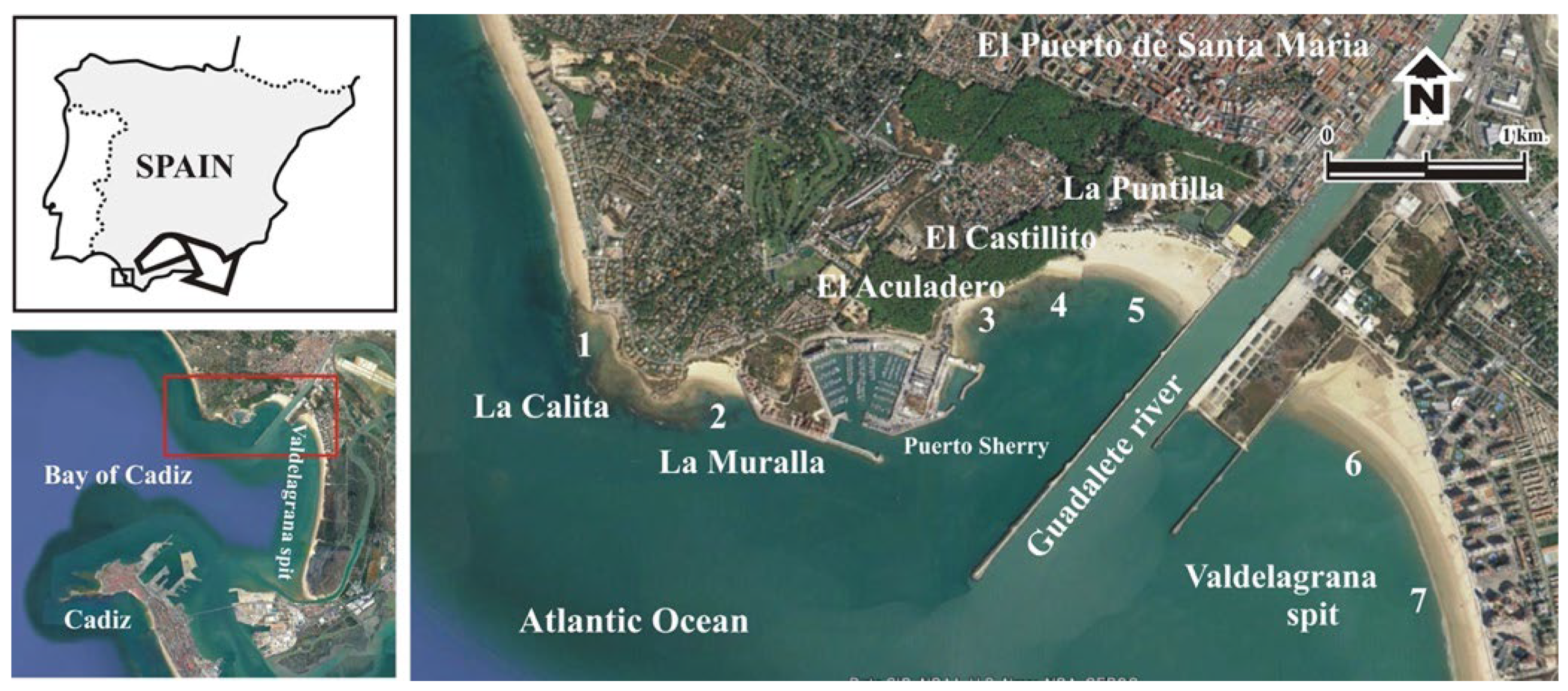

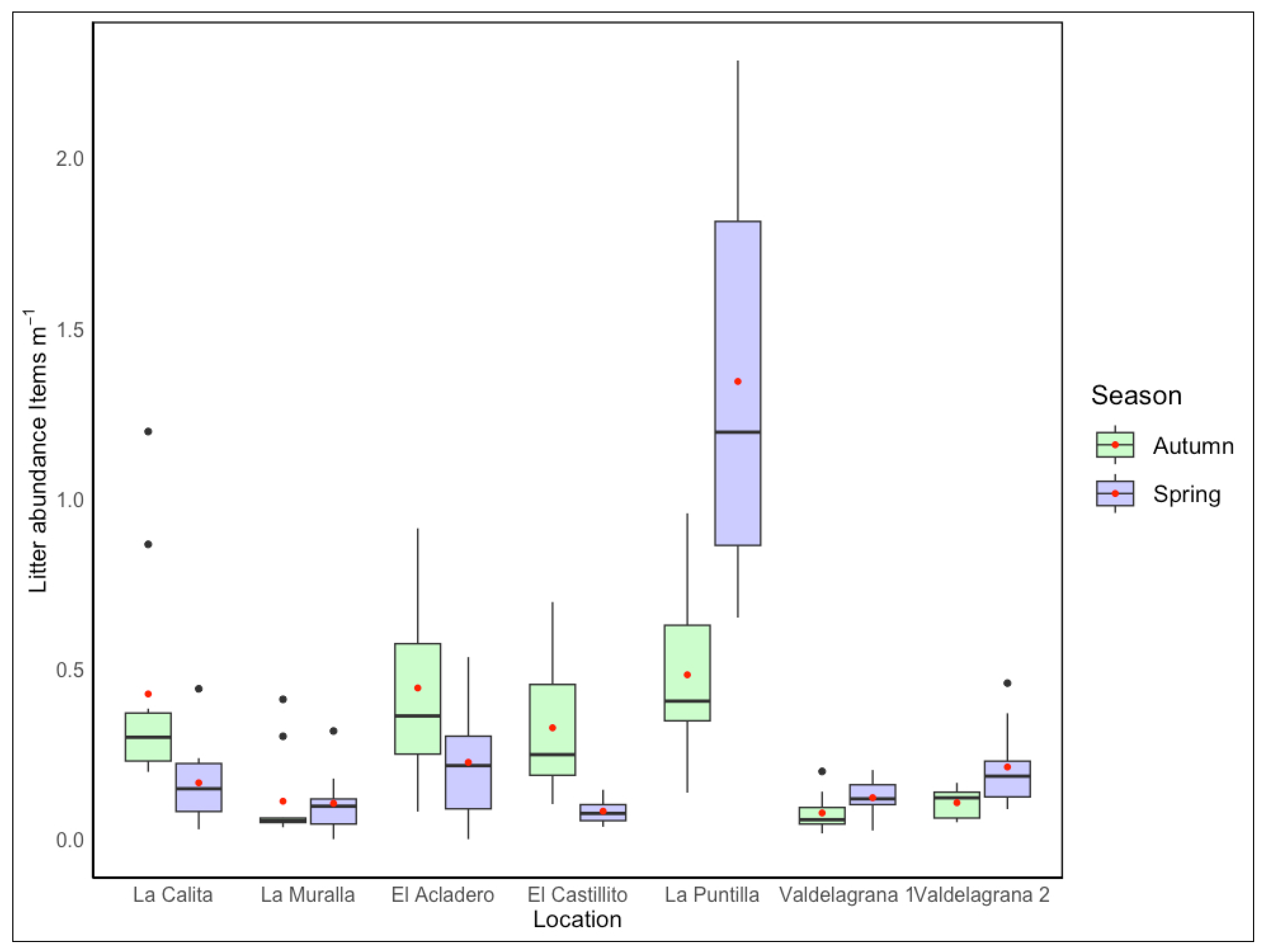
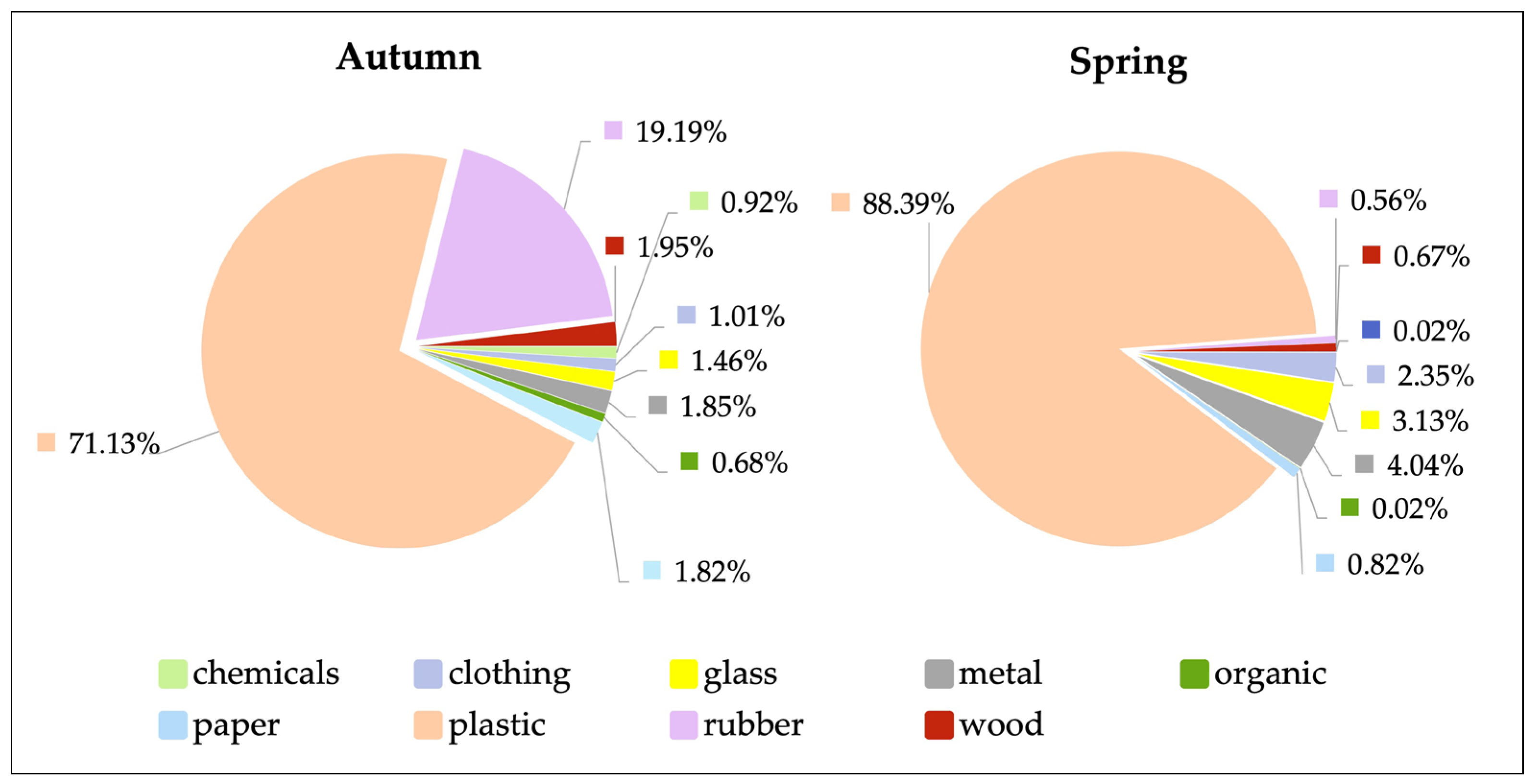




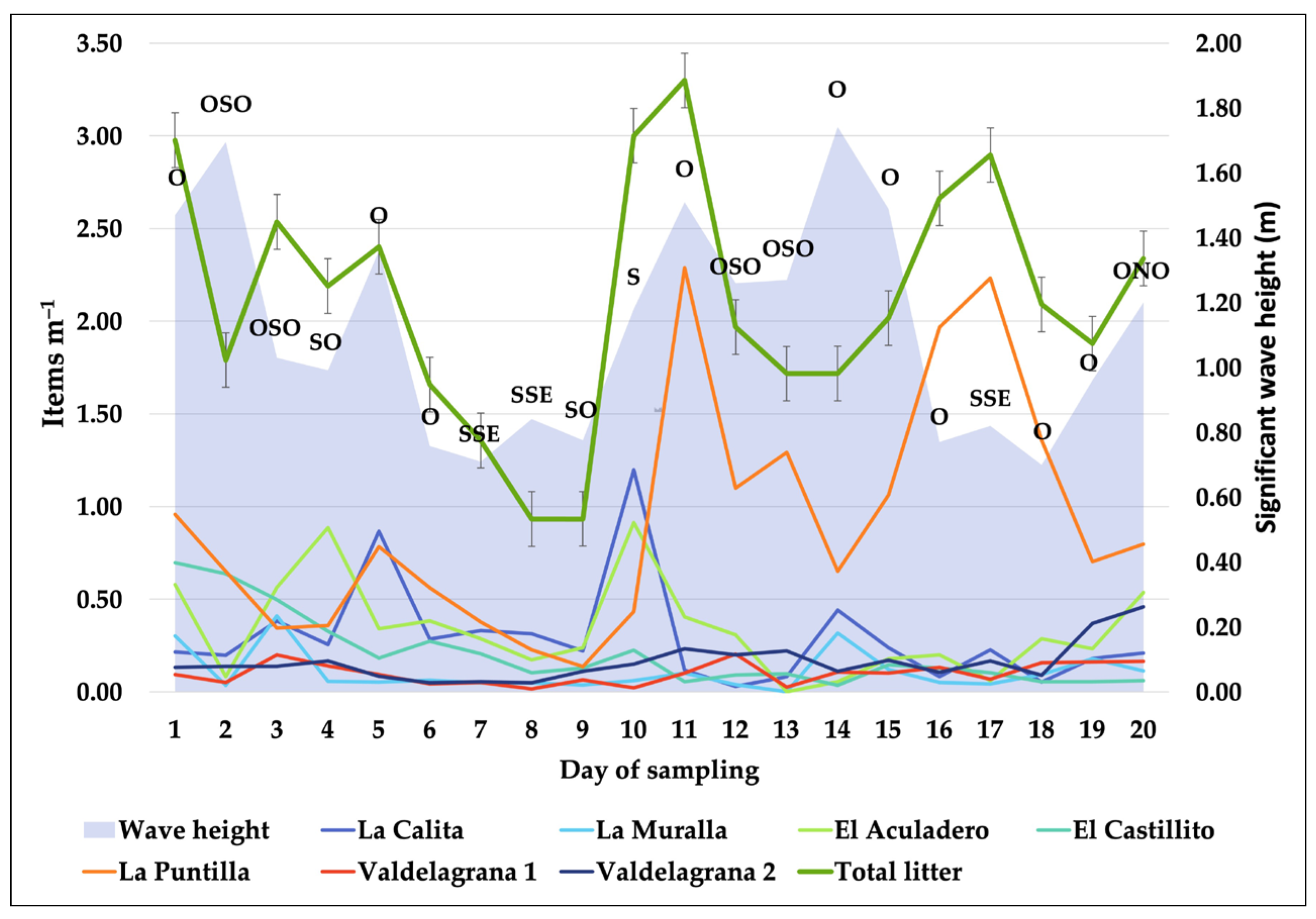


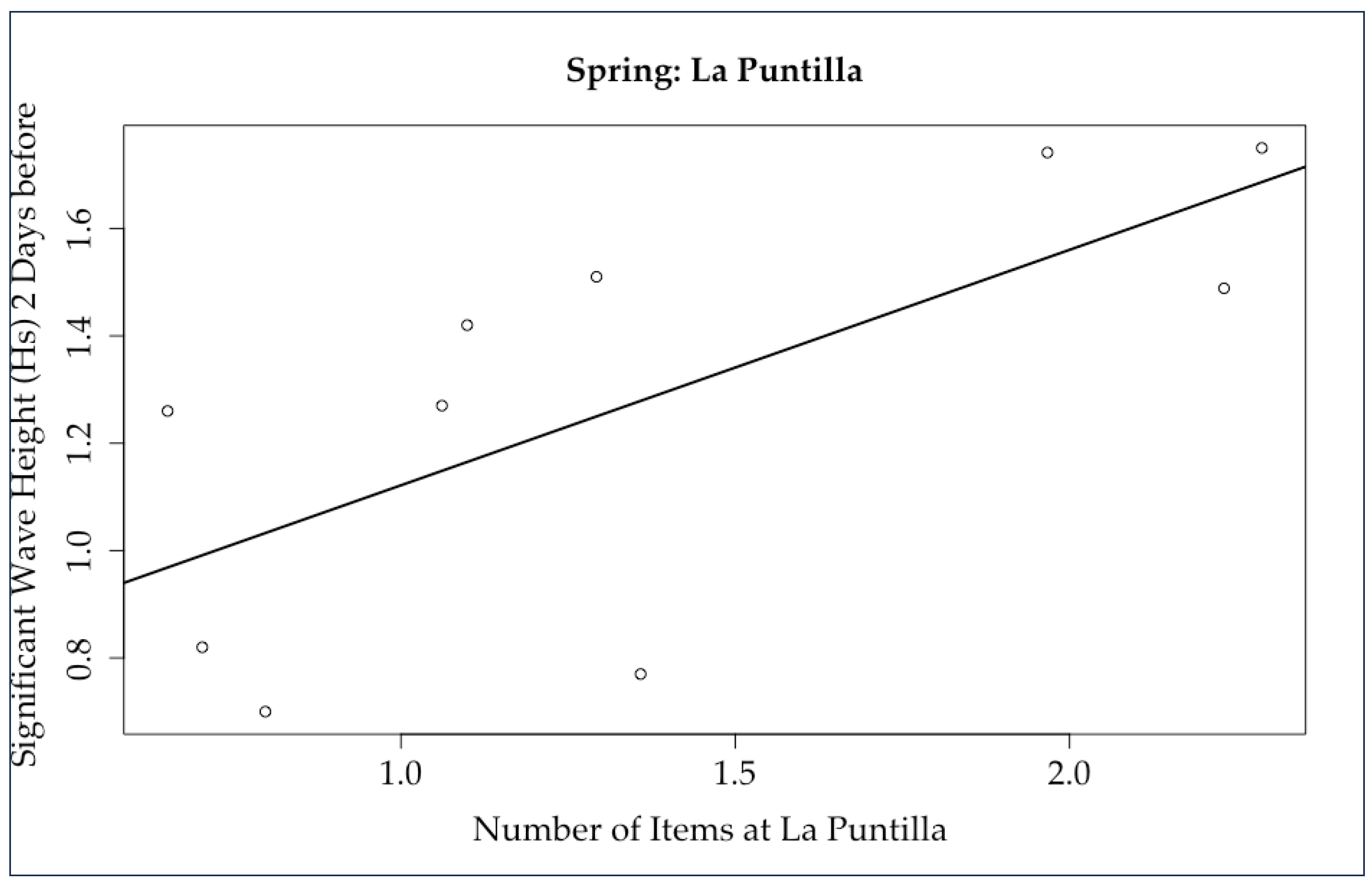


| Sector No. | Sector Length (m) | Location (Beach Name) | Beach Characteristic |
|---|---|---|---|
| 1 | 172 | La Calita | Exposed |
| 2 | 258 | La Muralla | Exposed |
| 3 | 185 | El Aculadero | Sheltered |
| 4 | 165 | El Castillito | Sheltered |
| 5 | 212 | La Puntilla | Sheltered |
| 6 | 236 | Valdelagrana 1 | Sheltered |
| 7 | 181 | Valdelagrana 2 | Exposed |
| Beach | Items m−1 | Items m−2 | ||||
|---|---|---|---|---|---|---|
| Autumn | Spring | Total | Autumn | Spring | Total | |
| La Calita | 0.43 ± 0.33 | 0.17 ± 0.12 | 0.42 ± 0.51 | 0.09 ± 0.07 | 0.03 ± 0.02 | 0.6 ± 0.6 |
| La Muralla | 0.11 ± 0.13 | 0.11 ± 0.09 | 0.19 ± 0.31 | 0.05 ± 0.01 | 0.02 ± 0.02 | 0.4 ± 0.2 |
| El Aculadero | 0.44 ± 0.29 | 0.23 ± 0.17 | 0.51 ± 0.65 | 0.09 ± 0.06 | 0.05 ± 0.03 | 0.7 ± 0.05 |
| El Castillito | 0.33 ±0.21 | 0.08 ± 0.04 | 0.27 ± 0.28 | 0.07 ± 0.04 | 0.04 ± 0.01 | 0.4 ± 0.4 |
| La Puntilla | 0.48 ± 0.25 | 1.34 ± 0.61 | 1.94 ± 3.98 | 0.10 ± 0.05 | 0.27 ± 0.12 | 0.18 ± 0.13 |
| Valdelagrana 1 | 0.08 ± 0.06 | 0.12 ± 0.05 | 0.19 ± 0.36 | 0.02 ± 0.01 | 0.02 ± 0.01 | 0.2 ± 0.1 |
| Valdelagrana 2 | 0.11 ± 0.04 | 0.21 ± 0.12 | 0.33 ± 0.62 | 0.02 ± 0.01 | 0.04 ± 0.02 | 0.3 ± 0.2 |
| Total | 0.28 ± 0.18 | 0.32 ± 0.45 | 0.63 ± 0.62 | 0.6 ± 0.3 | 0.06 ± 0.09 | 0.08 ± 0.06 |
| Location | La Calita | La Muralla | El Aculadero | El Castillito | La Puntilla | Valdelagrana 1 | Valdelagrana 2 |
|---|---|---|---|---|---|---|---|
| p-value | <0.01 | <0.01 | 0.051 | <0.01 | <0.01 | 0.082 | <0.01 |
| Autumn | Spring | ||
|---|---|---|---|
| Category | Total Items | Category | Total Items |
| Tobacco products with filters (cigarette butts with filters) | 1746 | Plastic wet wipes | 900 |
| Fragments of non-foamed plastic 2.5–50 cm | 985 | Tobacco products with filters (cigarette butts with filters) | 514 |
| Plastic crisps packets/sweets wrappers | 297 | Plastic crisps packets/sweets wrappers | 423 |
| Fragments of foamed polystyrene 2.5–50 cm | 181 | Fragments of non-foamed plastic 2.5–50 cm | 339 |
| Other identifiable non-foamed plastic items | 177 | Fragments of foamed polystyrene 2.5–50 cm | 211 |
| Plastic string and cord (diameter less than 1 cm) not from dolly ropes or unidentified | 96 | Other plastic string and filaments exclusively from fishery | 167 |
| Other identifiable foamed plastic items | 85 | Plastic shopping/carrier/grocery bags | 150 |
| Plastic cotton bud sticks | 68 | Pieces of glass/ceramic (glass or ceramic fragments ≥ 2.5 cm) | 142 |
| Plastic shopping/carrier/grocery bags | 56 | Plastic tangled wet wipes | 142 |
| Other processed wooden items 2.5–50 cm | 51 | Plastic fishing line | 120 |
| Date | Wind | Wave | |||
|---|---|---|---|---|---|
| dd/mm/yy | Speed (m/s) | Direction of Origin (°) | Mean Direction of Origin (°) | Significant Wave Height (m) | Peak Period (s) |
| Autumn | |||||
| 20/10/22 | 3.28 | 205 | 261 | 1.47 | 8 |
| 21/10/22 | 4.35 | 220 | 251 | 1.70 | 13.3 |
| 22/10/22 | 2.51 | 207 | 252 | 1.03 | 11 |
| 23/10/22 | 3.11 | 214 | 222 | 0.99 | 5.72 |
| 24/10/22 | 1.10 | 5 | 260 | 1.36 | 12.1 |
| 25/10/22 | 3.48 | 96 | 264 | 0.76 | 7.5 |
| 26/10/22 | 0.63 | 208 | 262 | 0.71 | 7.5 |
| 27/10/22 | 6.02 | 157 | 163 | 0.84 | 3.9 |
| 28/10/22 | 4.45 | 133 | 235 | 0.77 | 8.4 |
| 29/10/22 | 9.80 | 123 | 186 | 1.18 | 10.14 |
| Spring | |||||
| 15/03/23 | 6.32 | 297 | 262 | 1.51 | 12.1 |
| 16/03/23 | 6.8 | 118 | 245 | 1.26 | 11 |
| 17/03/23 | 6.85 | 199 | 227 | 1.27 | 15.22 |
| 18/03/23 | 6.97 | 280 | 275 | 1.74 | 14.37 |
| 19/03/23 | 5.36 | 311 | 277 | 1.49 | 11.88 |
| 20/03/23 | 1.71 | 11 | 275 | 0.77 | 10.79 |
| 21/03/23 | 0.53 | 19 | 154 | 0.82 | 11.58 |
| 22/03/23 | 1.57 | 292 | 263 | 0.70 | 12.44 |
| 23/03/23 | 4.42 | 327 | 281 | 0.96 | 11.85 |
Disclaimer/Publisher’s Note: The statements, opinions and data contained in all publications are solely those of the individual author(s) and contributor(s) and not of MDPI and/or the editor(s). MDPI and/or the editor(s) disclaim responsibility for any injury to people or property resulting from any ideas, methods, instructions or products referred to in the content. |
© 2024 by the authors. Licensee MDPI, Basel, Switzerland. This article is an open access article distributed under the terms and conditions of the Creative Commons Attribution (CC BY) license (https://creativecommons.org/licenses/by/4.0/).
Share and Cite
Ciufegni, E.; Anfuso, G.; Gutiérrez Romero, J.C.; Asensio-Montesinos, F.; Rodríguez Castle, C.; González, C.J.; Álvarez, O. Spatial and Temporal Deposition Rate of Beach Litter in Cadiz Bay (Southwest Spain). Sustainability 2024, 16, 1010. https://doi.org/10.3390/su16031010
Ciufegni E, Anfuso G, Gutiérrez Romero JC, Asensio-Montesinos F, Rodríguez Castle C, González CJ, Álvarez O. Spatial and Temporal Deposition Rate of Beach Litter in Cadiz Bay (Southwest Spain). Sustainability. 2024; 16(3):1010. https://doi.org/10.3390/su16031010
Chicago/Turabian StyleCiufegni, Elisabetta, Giorgio Anfuso, Julia Cristina Gutiérrez Romero, Francisco Asensio-Montesinos, Christian Rodríguez Castle, Carlos J. González, and Oscar Álvarez. 2024. "Spatial and Temporal Deposition Rate of Beach Litter in Cadiz Bay (Southwest Spain)" Sustainability 16, no. 3: 1010. https://doi.org/10.3390/su16031010
APA StyleCiufegni, E., Anfuso, G., Gutiérrez Romero, J. C., Asensio-Montesinos, F., Rodríguez Castle, C., González, C. J., & Álvarez, O. (2024). Spatial and Temporal Deposition Rate of Beach Litter in Cadiz Bay (Southwest Spain). Sustainability, 16(3), 1010. https://doi.org/10.3390/su16031010








